Effects of Pine Needle Extracts on the Degradation of LLDPE
Abstract
1. Introduction
2. Materials and Methods
2.1. Materials and Instruments
2.2. Sample Preparation
2.3. Characterizations
3. Results and Discussion
3.1. Main Components and Antioxidant Capacity of Pine Needle Extracts
3.2. Effect of Pine Needle Extracts on Short-Term Aging Resistance
3.3. Effects of Pine Needle Extracts on Long-Term Aging Resistance
3.4. Effects of Pine Needle Extract on Processing Stability
3.5. Mechanical Properties
4. Conclusions
Author Contributions
Funding
Institutional Review Board Statement
Informed Consent Statement
Data Availability Statement
Acknowledgments
Conflicts of Interest
References
- Zhang, Y.; Li, H.; Li, M.; Liu, W.; Li, Q.; Hu, Y. Synthesis and Properties of Novel Polyethylene-Based Antioxidants with Hindered Phenols as Side Groups. Macromol. Chem. Phys. 2019, 221, 1900410. [Google Scholar] [CrossRef]
- Kirschweng, B.; Tátraaljai, D.; Földes, E.; Pukánszky, B. Natural antioxidants as stabilizers for polymers. Polym. Degrad. Stab. 2017, 145, 25–40. [Google Scholar] [CrossRef]
- Liao, J.; Brosse, N.; Pizzi, A.; Hoppe, S.; Xi, X.; Zhou, X. Polypropylene Blend with Polyphenols through Dynamic Vulcanization: Mechanical, Rheological, Crystalline, Thermal, and UV Protective Property. Polymers 2019, 11, 1108. [Google Scholar] [CrossRef] [PubMed]
- Kirschweng, B.; Vörös, B.; Tátraaljai, D.; Zsuga, M.; Földes, E.; Pukánszky, B. Natural antioxidants as melt stabilizers for PE: Comparison of silymarin and quercetin. Eur. Polym. J. 2017, 90, 456–466. [Google Scholar] [CrossRef]
- Kirschweng, B.; Tilinger, D.M.; Hégely, B.; Samu, G.; Tátraaljai, D.; Földes, E.; Pukánszky, B. Melt stabilization of PE with natural antioxidants: Comparison of rutin and quercetin. Eur. Polym. J. 2018, 103, 228–237. [Google Scholar] [CrossRef]
- Tátraaljai, D.; Földes, E.; Pukánszky, B. Efficient melt stabilization of polyethylene with quercetin, a flavonoid type natural antioxidant. Polym. Degrad. Stab. 2014, 102, 41–48. [Google Scholar] [CrossRef]
- Kirschweng, B.; Bencze, K.; Sárközi, M.; Hégely, B.; Samu, G.; Hári, J.; Tátraaljai, D.; Földes, E.; Kállay, M.; Pukánszky, B. Melt stabilization of polyethylene with dihydromyricetin, a natural antioxidant. Polym. Degrad. Stab. 2016, 133, 192–200. [Google Scholar] [CrossRef]
- Tátraaljai, D.; Major, L.; Földes, E.; Pukánszky, B. Study of the effect of natural antioxidants in polyethylene: Performance of β-carotene. Polym. Degrad. Stab. 2014, 102, 33–40. [Google Scholar] [CrossRef]
- Koontz, J.L.; Marcy, J.E.; O’Keefe, S.F.; Duncan, S.E.; Long, T.E.; Moffitt, R.D. Polymer processing and characterization of LLDPE films loaded with α-tocopherol, quercetin, and their cyclodextrin inclusion complexes. J. Appl. Polym. Sci. 2010, 117, 2299–2309. [Google Scholar] [CrossRef]
- Ambrogi, V.; Cerruti, P.; Carfagna, C.; Malinconico, M.; Marturano, V.; Perrotti, M.; Persico, P. Natural antioxidants for polypropylene stabilization. Polym. Degrad. Stab. 2011, 96, 2152–2158. [Google Scholar] [CrossRef]
- Bellucci, E.R.B.; Munekata, P.E.S.; Pateiro, M.; Lorenzo, J.M.; da Silva Barretto, A.C. Red pitaya extract as natural antioxidant in pork patties with total replacement of animal fat. Meat Sci 2021, 171, 108284. [Google Scholar] [CrossRef] [PubMed]
- Cerruti, P.; Malinconico, M.; Rychly, J.; Matisova-Rychla, L.; Carfagna, C. Effect of natural antioxidants on the stability of polypropylene films. Pol. Degrad. Stab. 2009, 94, 2095–2100. [Google Scholar] [CrossRef]
- Liebler, D.C.; Mcclure, T.D. Antioxidant reactions of β-carotene: Identification of carotenoid-radical adducts. Chem. Res. Teicol. 1996, 9, 8–11. [Google Scholar] [CrossRef] [PubMed]
- Mónica, G.; Verstraeten, S.V.; Oteiza, P.I.; Fraga, C.G. Antioxidant actions of flavonoids: Thermodynamic and kinetic analysis. Archi. Biochem. Biophys. 2010, 501, 23–30. [Google Scholar]
- Tátraaljai, D.; Kirschweng, B.; Kovács, J.; Földes, E.; Pukánszky, B. Processing stabilisation of PE with a natural antioxidant, curcumin. Eur. Polym. J. 2013, 49, 1196–1203. [Google Scholar] [CrossRef]
- Nanni, A.; Messori, M. A comparative study of different winemaking by-products derived additives on oxidation stability, mechanical and thermal proprieties of polypropylene. Pol. Degrad. Stab. 2018, 149, 9–18. [Google Scholar] [CrossRef]
- Diouf-Lewis, A.; Commereuc, S.; Verney, V. Biowastes from wine as natural additive of polyolefins: Thermo- and photo-oxidation efficiency. J. Appl. Polym. Sci. 2018, 135, 46607. [Google Scholar] [CrossRef]
- Battegazzore, D.; Bocchini, S.; Alongi, J.; Frache, A. Plasticizers, antioxidants and reinforcement fillers from hazelnut skin and cocoa by-products: Extraction and use in PLA and PP. Pol. Degrad. Stab. 2014, 108, 297–306. [Google Scholar] [CrossRef]
- Iyer, K.A.; Zhang, L.H.; Torkelson, J.M. Direct use of natural antioxidant-rich agro-wastes as thermal stabilizer for polymer: Processing and recycling. ACS Sustain. Chem. Eng. 2016, 4, 881–889. [Google Scholar] [CrossRef]
- Xia, H.M.; Gao, H.; Zhang, Y.X.; Wang, Z.; Song, L.; Liu, L.; Tian, X.J.; Huang, X.W.; Yu, Q. Natural antioxidant from bamboo leaves for the processing stability of polypropylene. J. Anal. Calorim. 2021, 146, 1657–1665. [Google Scholar] [CrossRef]
- Xia, H.M.; Sui, K.; Ge, T.; Wu, F.; Sun, Q.; Wang, Z.W.; Song, L.; Huang, X.W.; Yu, Q. Natural compounds from Punica granatum peel as multiple stabilizers for polyethylene. Polym. Eng. Sci. 2020, 60, 2761–2769. [Google Scholar] [CrossRef]
- Xia, H.M.; Gao, H.; Sun, Q.Q.; Wu, F.Z.; Ge, T.T.; Sui, K.; Wang, Z.W.; Song, L.; Huang, X.W.; Yu, Q. Puerarin, an efficient naural stabilizer for bothpolyethylene and polypropylene. J. Appl. Polym. Sci. 2020, 137, 49599. [Google Scholar] [CrossRef]
- Sui, K.; Mei, F.C.; Li, X.Y.; Wang, Z.F.; Wang, Z.W.; Han, Y.X.; Yu, Q.; Cheng, Q.Q. Forsythia suspensa extract obtained from traditional Chinese herbal medicine as an efficient natural antioxidant for polyethylene. J. Polym Res 2022, 29, 494. [Google Scholar] [CrossRef]
- Shu, P.; Li, J.; Fei, Y.; Zhu, H.; Yu, M.; Liu, A.; Niu, H.; Zou, S.; Wei, X.; Ju, Z.; et al. Isolation, structure elucidation, tyrosinase inhibitory, and antioxidant evaluation of the constituents from Angelica dahurica roots. J. Nat. Med. 2020, 74, 456–462. [Google Scholar] [CrossRef] [PubMed]
- Wang, T.; Xu, Y.Y.; Chen, S.H.; Yan, M.Q.; Lu, G.Y.; Liu, T. Research progress on Health care efficacy of pine needles and related products. Chin. Herb. Med. 2018, 49, 4171–4177. [Google Scholar]
- Bi, Y.F.; Zheng, X.K.; Liu, H.M.; Feng, W.S.; Ji, C.R.; Zhang, Y.Z. Study on chemical constituents of Pinus massoniana Needle. Acta Pharmacol. Sin. 2001, 11, 832–835. [Google Scholar]
- Kwak, C.S.; Moon, S.C.; Lee, M.S. Antioxidant, antimutagenic and antitumor effects of pine needles (Pinus densiflora). Nutr. Cancer 2006, 56, 162–171. [Google Scholar] [CrossRef]
- Xun, E.N.; Zhang, C.L.; Xie, X.N.; Chen, S.P.; Zhou, X.H.; Wang, J.X.; Wang, L.Z. Ultrasonic extraction of polyphenols from pine needles. J. Jilin Univ. (Nat. Sci. Ed.) 2012, 50, 147–152. [Google Scholar]
- Fan, Z.L.; Chen, K.L.; Gao, X.; Bao, Y.H. Extraction optimization and antioxidant activity of five pine needle polyphenols. Mod. Food Sci. Technol. 2017, 33, 211–220. [Google Scholar]
- Jiang, L.; Zeng, H.; Ni, L.; Qi, L.; Xu, Y.; Xia, L.; Yu, Y.; Liu, B.; Yang, H.; Hao, H.; et al. HIF-1alpha Preconditioning Potentiates Antioxidant Activity in Ischemic Injury: The Role of Sequential Administration of Dihydrotanshinone I and Protocatechuic Aldehyde in Cardioprotection. Antioxid Redox Signal 2019, 31, 227–242. [Google Scholar] [CrossRef]
- Foti, M.C. Antioxidant properties of phenols. J. Pharm. Pharm. 2007, 59, 1673–1685. [Google Scholar] [CrossRef] [PubMed]
- Wang, M.; Jiang, N.; Wang, Y.; Jiang, D.; Feng, X. Characterization of Phenolic Compounds from Early and Late Ripening Sweet Cherries and Their Antioxidant and Antifungal Activities. J. Agric. Food Chem. 2017, 65, 5413–5420. [Google Scholar] [CrossRef] [PubMed]
- Rajagukguk, Y.V.; Arnold, M.; Sidor, A.; Kulczyński, B.; Brzozowska, A.; Schmidt, M.; Gramza-Michałowska, A. Antioxidant Activity, Probiotic Survivability, and Sensory Properties of a Phenolic-Rich Pulse Snack Bar Enriched with Lactiplantibacillus plantarum. Foods 2022, 11, 309. [Google Scholar] [CrossRef] [PubMed]
- Qasim, M.; Abideen, Z.; Adnan, M.Y.; Gulzar, S.; Gul, B.; Rasheed, M.; Khan, M.A. Antioxidant properties, phenolic composition, bioactive compounds and nutritive value of medicinal halophytes commonly used as herbal teas. S. Afr. J. Bot. 2017, 110, 240–250. [Google Scholar] [CrossRef]
- Mar’in, A.; Greci, L.; Dubs, P. Antioxidative activity of 3-aryl-benzofuran-2-one stabilizers (Irganox®HP-136) in polypropylene. Polym. Degrad. Stab. 2002, 76, 489–494. [Google Scholar] [CrossRef]
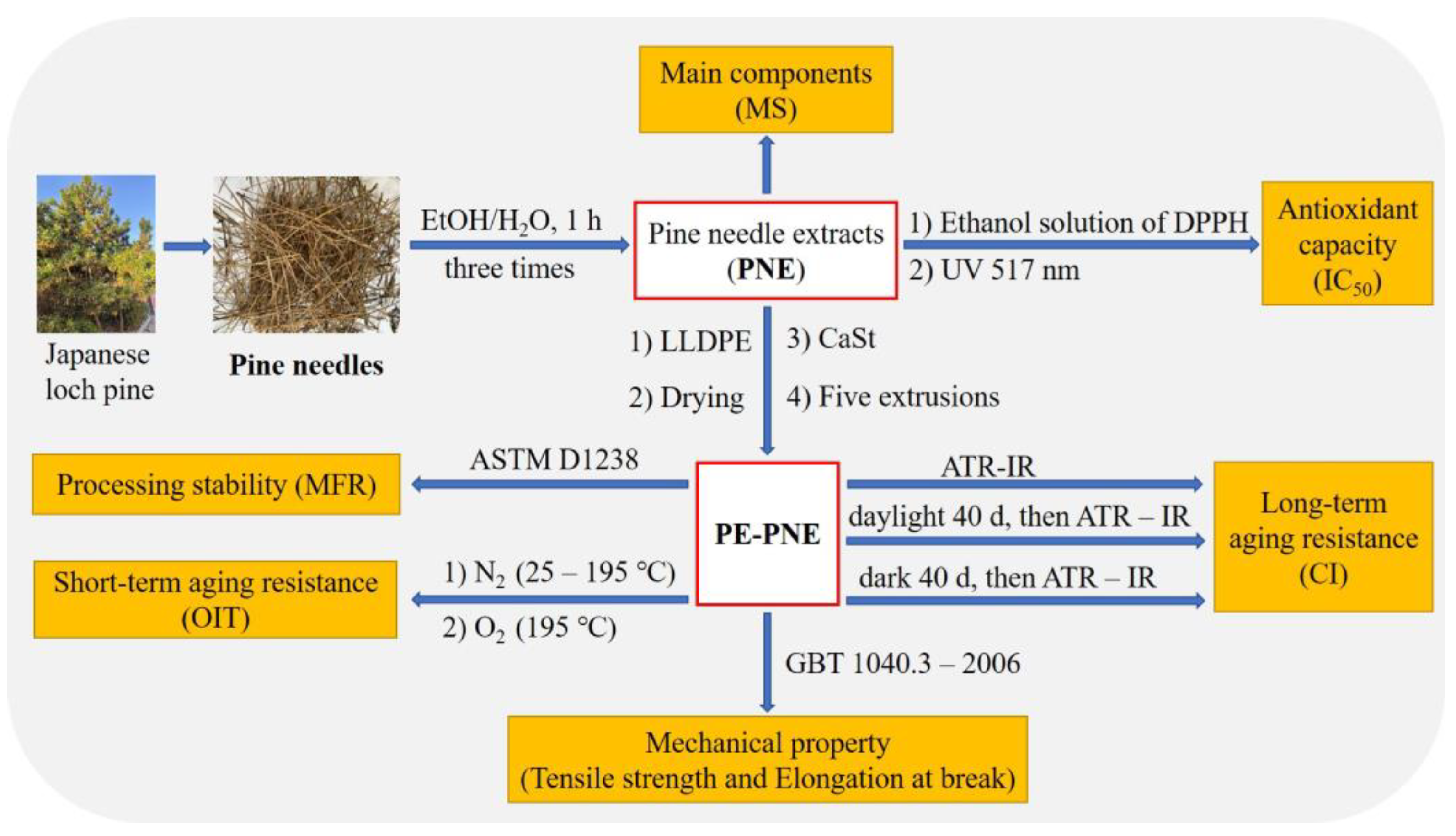
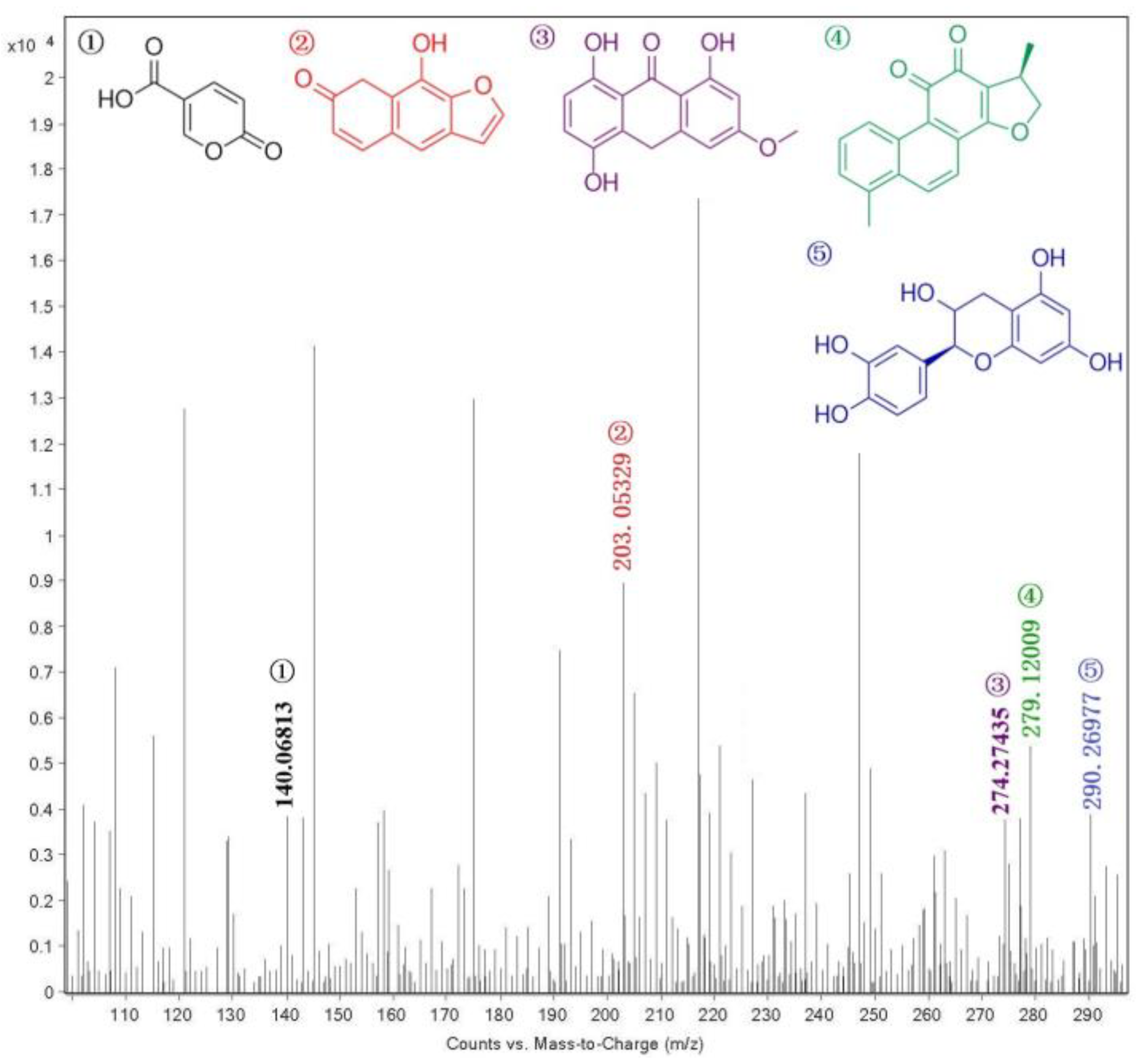

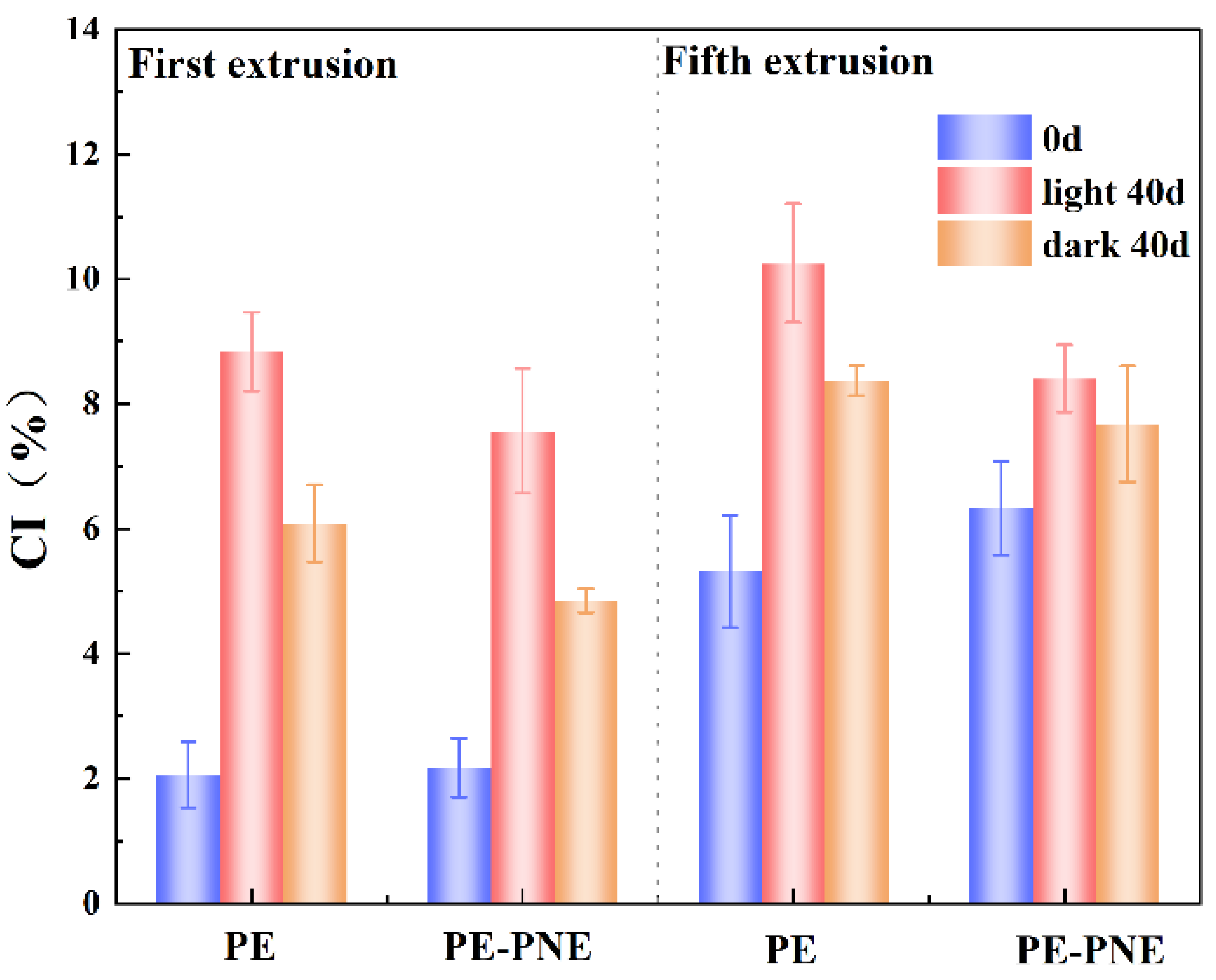

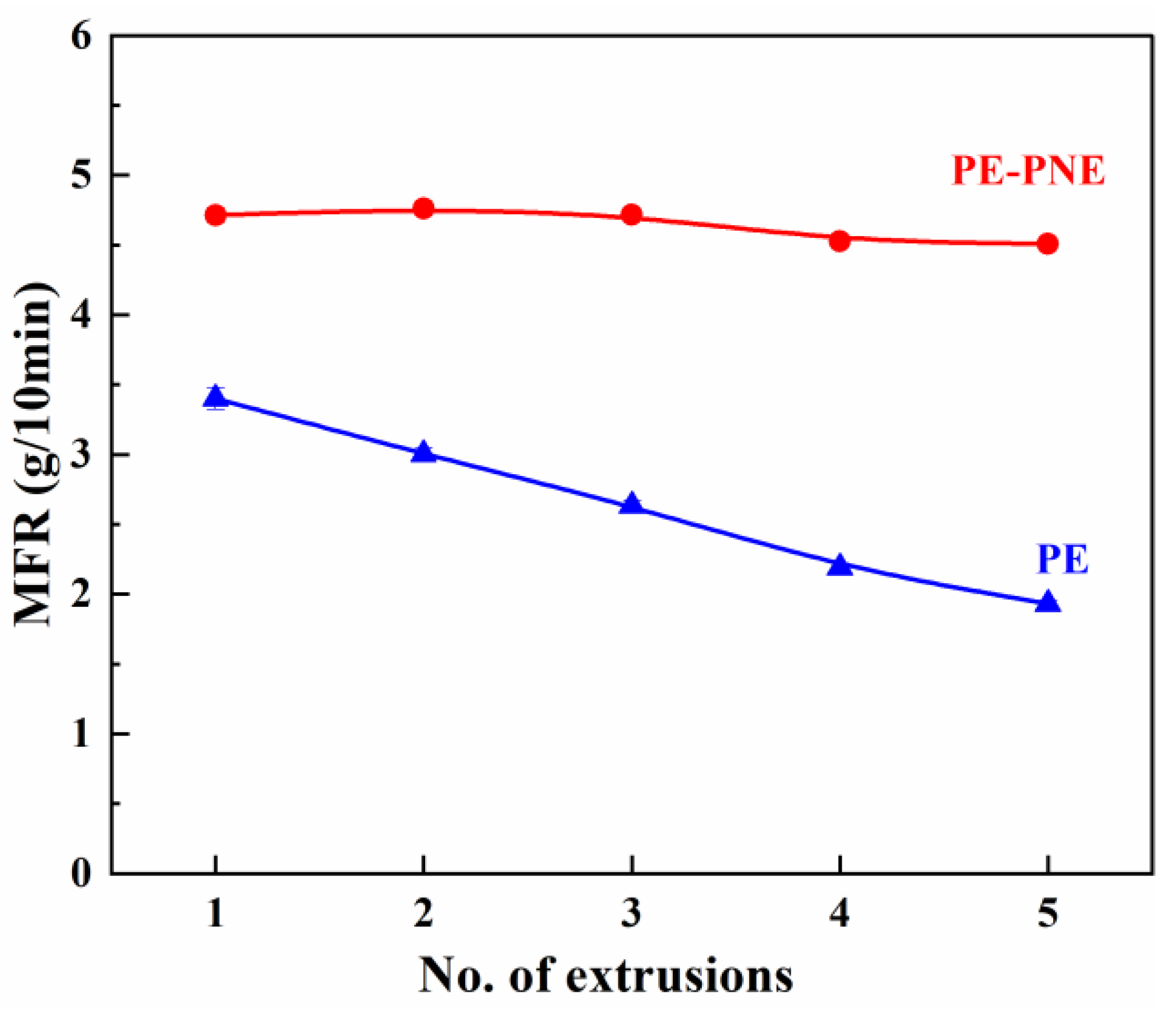
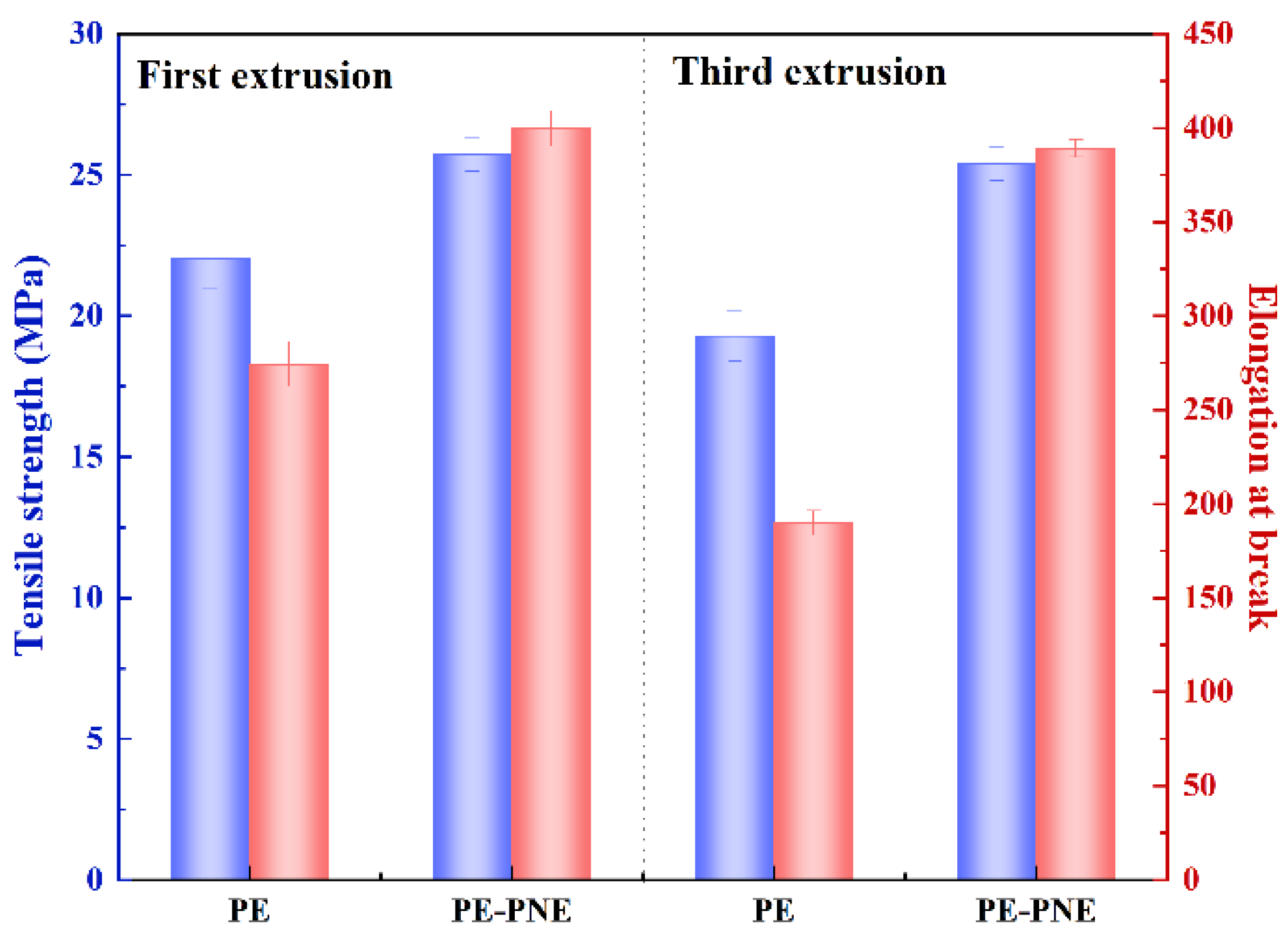
| Samples | First Extrusion | Fifth Extrusion | ||
|---|---|---|---|---|
| PE | PE-PNE | PE | PE-PNE | |
| ΔCI (under daylight, %) | 329.1 | 248.8 | 92.8 | 32.8 |
| ΔCI (in the dark, %) | 195.6 | 123.5 | 57.3 | 21.3 |
Disclaimer/Publisher’s Note: The statements, opinions and data contained in all publications are solely those of the individual author(s) and contributor(s) and not of MDPI and/or the editor(s). MDPI and/or the editor(s) disclaim responsibility for any injury to people or property resulting from any ideas, methods, instructions or products referred to in the content. |
© 2022 by the authors. Licensee MDPI, Basel, Switzerland. This article is an open access article distributed under the terms and conditions of the Creative Commons Attribution (CC BY) license (https://creativecommons.org/licenses/by/4.0/).
Share and Cite
Li, X.; Zhang, J.; Liu, C.; Mu, W.; Kong, Z.; Li, Y.; Wang, Z.; Yu, Q.; Cheng, G.; Chen, L. Effects of Pine Needle Extracts on the Degradation of LLDPE. Polymers 2023, 15, 32. https://doi.org/10.3390/polym15010032
Li X, Zhang J, Liu C, Mu W, Kong Z, Li Y, Wang Z, Yu Q, Cheng G, Chen L. Effects of Pine Needle Extracts on the Degradation of LLDPE. Polymers. 2023; 15(1):32. https://doi.org/10.3390/polym15010032
Chicago/Turabian StyleLi, Xiangyao, Jie Zhang, Chengchao Liu, Wenmin Mu, Zhe Kong, Yan Li, Zhongwei Wang, Qing Yu, Guiqing Cheng, and Long Chen. 2023. "Effects of Pine Needle Extracts on the Degradation of LLDPE" Polymers 15, no. 1: 32. https://doi.org/10.3390/polym15010032
APA StyleLi, X., Zhang, J., Liu, C., Mu, W., Kong, Z., Li, Y., Wang, Z., Yu, Q., Cheng, G., & Chen, L. (2023). Effects of Pine Needle Extracts on the Degradation of LLDPE. Polymers, 15(1), 32. https://doi.org/10.3390/polym15010032







